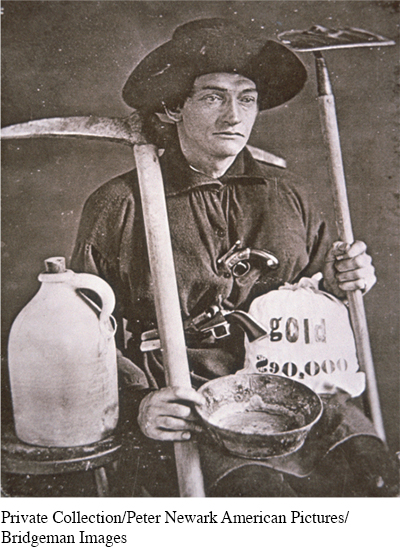The Gold Rush
Despite the hazards, more and more Americans traveled overland to the Pacific coast, although only a few thousand Americans initially settled in California. Some were agents sent there by eastern merchants to purchase fine leather made from the hides of Spanish cattle. Several agents married into families of elite Mexican ranchers, known as Californios, and adopted their culture, even converting to Catholicism.
However, the Anglo-American presence in California changed dramatically after 1848 when gold was discovered at Sutter’s Mill in northeastern California. Beginning in 1849 news of the discovery brought tens of thousands of settlers from the eastern United States, South America, Europe, and Asia. In the gold rush, “forty-niners” raced to claim riches in California, and men vastly outnumbered women.
The rapid influx of gold seekers heightened tensions between newly arrived whites, local Indians, and Californios. Forty-niners confiscated land owned by Californios, shattered the fragile ecosystem in the California mountains, and forced Mexican and Indian men to labor for low wages or a promised share in uncertain profits. New conflicts erupted when migrants from Asia and South America joined the search for wealth. Forty-niners from the United States regularly stole from and assaulted these foreign-born competitors.

The gold rush also led to the increased exploitation of women as thousands of male migrants demanded food, shelter, laundry, and medical care. While some California women earned a good living by renting rooms, cooking meals, washing clothes, or working as prostitutes, many faced exploitation and abuse. Indian and Mexican women were especially vulnerable to sexual harassment and rape, while Chinese women were imported specifically to provide sexual services for male miners.
Chinese men were also victims of abuse by whites, who ran them off their claims. Yet some Chinese men used the skills traditionally assigned them in their homeland—cooking and washing clothes—to earn a far steadier income than prospecting for gold could provide. Other men also took advantage of the demand for goods and services. Levi Strauss, a German Jewish immigrant, moved from New York to San Francisco to open a dry-goods store in 1853. He soon made his fortune producing canvas and then denim pants that could withstand harsh weather and long wear.
Exploring American HistoriesPrinted Page 387
Exploring American Histories Value EditionPrinted Page 284
Chapter Timeline